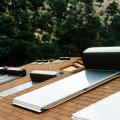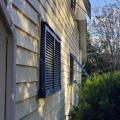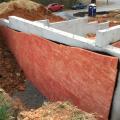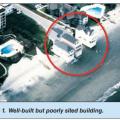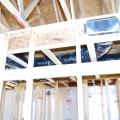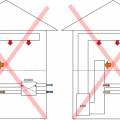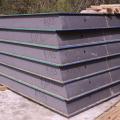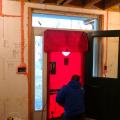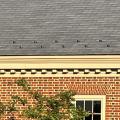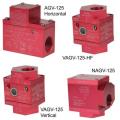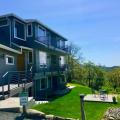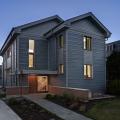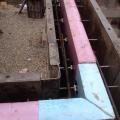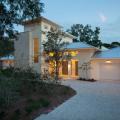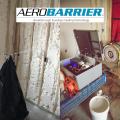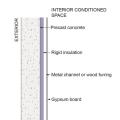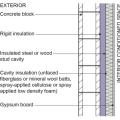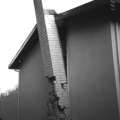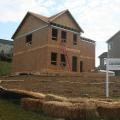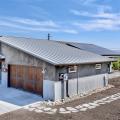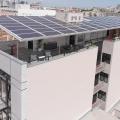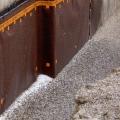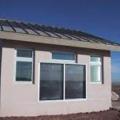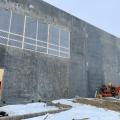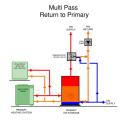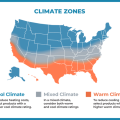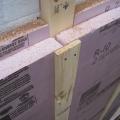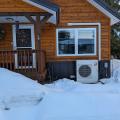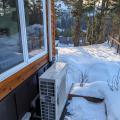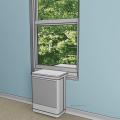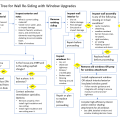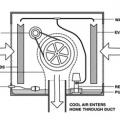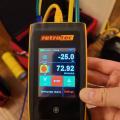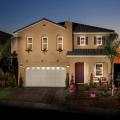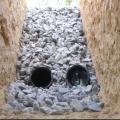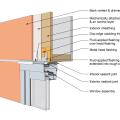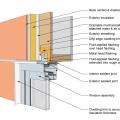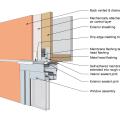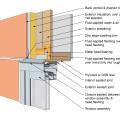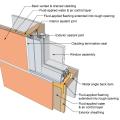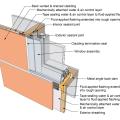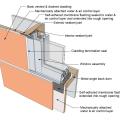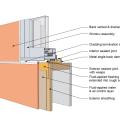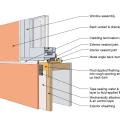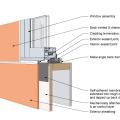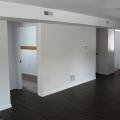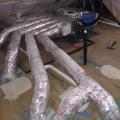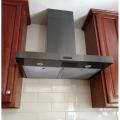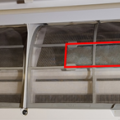Showing results 3801 - 3900 of 4973
These aluminum Bahama shutters shade west-facing windows from afternoon sun and are approved for hurricane protection
These apartments built by Haynes Construction in Meriden, Connecticut, achieved certification to both the U.S. Department of Energy’s Zero Energy Ready Home Program and the Passive House Institute U.S. and were funded as affordable housing.
These below-grade walls are insulated along the exterior with R-5 of bug-resistant high-density rigid fiberglass insulation installed over damproofing.
These buildings may be well constructed but are poorly sited too close to waves and constantly at risk due to erosion and flooding.
These ducts were installed within the home's conditioned space in a central chaise down the main hallway.
These ERV/HRV configurations are NOT recommended because outdoor air can be sucked back into the ERV/HRV before being distributed to the living space
These factory-built walls consist of 9.5-inch I-studs sheathed with coated OSB, faced with OSB, and dense-packed with cellulose; a second interior surface of drywall is added to provide a 1.5-inch cavity for electrical wiring.
These floor joist bays have been properly air sealed with caulked rigid foam insulation
These garages attached to multifamily townhouses are open to the exterior, allowing for natural air changes to remove airborne contaminants from the garage.
These graphite-enhanced structural insulated panels come to the job site pre-cut and ready for quick assembly into an airtight, continuously insulated structure.
These ICF homes are blower door tested during construction, before the drywall is installed, when air leaks can be easily sealed.
These interior storm windows have low-emissivity coatings to let in light while keeping out heat in the summer and keeping heat in in the winter
These plots compare sizing approaches in terms of the approximate annual heating load a heat pump might carry throughout the year for a hypothetical home in Minneapolis, MN.
These second-story ventilation air intake/exhaust grilles can be accessed from the lower roof for air-flow testing
These snow guards help to keep snow from sliding off the roof and injuring people below.
These State of California-approved seismic gas shutoff valves (also known as earthquake valves) are installed on the fuel line from the meter to the home to stop the flow of natural gas if the sensor detects ground movement above about 5.4 (Richter)
These townhomes built by Haynes Construction in Meriden, Connecticut, achieved certification to both the U.S. Department of Energy’s Zero Energy Ready Home Program and the Passive House Institute U.S. and were funded as affordable housing.
These trees were planted between the sidewalk and the street, providing shade to homes, pedestrians, parked cars, and the street.
These two battery storage modules are charged by a 6 kW solar PV system during daytime hours and provide 27 kWh of whole house backup electricity storage
These walls are made of autoclaved aerated concrete blocks that are lightweight, easy to cut, bug-resistant, moisture-resistant, fire-resistant and steel-reinforced to form structurally solid, air-tight, thermally resistant walls.
These wildfire-resistant decks have a solid decking surface, metal railings, and the underside timber supports are covered with flame-resistant fiber cement board; also the decking is set back from the vegetated slope.
Thick beads of caulk will form a continuous seal between the subfloor and the wall’s bottom plate to keep out air and bugs.
This “high static ducted cassette” heat pump system is similar to a traditional centrally ducted system, serving several areas of a home from one indoor unit
This 13.8-kW array of solar panels is mounted on a steel pole with motorized dual-axis rotation to track the sun, maximizing electrical power generation.
This 2x6 wall is advanced framed and filled with dense-packed cellulose insulation.
This 3,600-ft2 home built by Weiss Building & Development, in River Forest, Illinois, is a certified U.S. Department of Energy (DOE) Zero Energy Ready Home and meets Passive House Institute U.S. requirements.
This 4-inch layer of rigid foam insulation (R-20) will be sandwiched between two layers of concrete poured on site for a highly insulated foundation wall.
This 4,305 ft2 zero energy ready home has almost no electric bills thanks to very high-efficiency construction and a solar electric system.
This above-ground private fire suppression cistern has a hydrant threaded for easy attachment to local fire department hoses.
This aerosol sealant process seals off small leaks in the building envelope with tiny particles of nontoxic acrylic sealant that are sprayed into the air while the home is pressurized with a blower door kit.
This air handler is located within the homes conditioned space in a closet on the main floor of the home (Source: Tommy Williams Homes).
This air handling unit provides outside air at the same rate as the air being exhausted from the bathroom exhaust fan; local kitchen exhaust is provided by a range hood with a dedicated makeup air intake and dehumidification is provided by a separate unit
This air-sealing approach uses the wall drywall to isolate the corridor from the individual units in a multifamily building that has a truss floor structural system
This asphalt-based, vapor-permeable coating is painted directly onto the OSB sheathing to provide a weather-resistant barrier that also reduces air leakage.
This assembly can be used to thermally isolate heated or partially heated garages with slab foundations from the exterior in multifamily row houses/townhouses in IECC Climate Zones 3 and higher.
This assembly for above-grade and below-grade garage walls in any climate zone uses continuous rigid insulation along the interior of the wall.
This assembly for above-grade or below-grade garage walls in any climate zone uses a hybrid of continuous rigid insulation and cavity insulation on the interior side of the wall.
This attic is insulated to R-64 with a hybrid application of 11 inches of open-cell spray foam (R-4.45/in) plus 2 inches of closed-cell spray foam (R-7.4/in) that completely fills the roof rafter cavities and encases the rafters.
This attic was insulated with 5 inches of closed-cell spray foam on the underside of the roof deck plus 6.5 inches of blown fiberglass covered with sheetrock as a firebreak for a total R-58 roof assembly insulation value.
This basement is insulated on the exterior with rigid foam over dampproofing, with granular backfill and footing drains to facilitate drainage away from the foundation, a termite shield to protect from pests, and cellular PVC to protect the rigid foam.
This bath exhaust fan ventilation control can be set by the HVAC technician for continuous operation, delayed shut off, or a set amount of minutes each hour
This bathroom is handicapped accessible with a zero-entry shower and roll-up sinks.
This breakaway wall beneath an elevated home in a coastal flood zone is made of wood attic.
This breakaway wall design made of decay resistant lumber is compliant with the National Flood Insurance Program.
This breakaway wall panel was prevented from breaking away cleanly by utility penetrations.
This builder applied an air-sealing layer of spray foam along the underside of the roof deck and the inside of the walls before filling the wall cavities with blown cellulose.
This builder employs good water runoff managementpractices to control sediment during construction and to ensure that stormwater drains away from the house after construction.
This builder in central Washington state chose durable low-maintenance exterior finishes like metal roofing, and hydrolyzed lime and metal siding.
This builder installed a PV panel awning over his multifamily project in San Francisco.
This builder installs spray foam in exterior wall cavities where tubs and showers will be installed to air seal and insulate the exterior wall.
This building foundation has a drainage layer located on the exterior of the waterproofing membrane.
This building has a south facing Trombe wall to take advantage of passive solar heating.
This Central Fan Integrated Supply (CFIS) duct is undersized and kinked, limiting required airflow This Central Fan Integrated Supply (CFIS) duct is undersized and kinked, limiting required airflow
This central heat pump water heating system with a hot water circulation loop that returns to the primary storage tank relies on a single pass heat pump to provide both primary DHW heating and hot water circulation temperature maintenance
This central heat pump water heating system with a hot water circulation loop that returns to the primary storage tank relies on a multi pass heat pump to provide both primary DHW heating and hot water circulation temperature maintenance
This central ventilation system uses an energy recovery ventilator, pre-conditioning unit, and elevator shaft exhaust fan to supply air to dwelling units and corridors and to exhaust air from units and the elevator shaft in a multifamily building
This chimney was not adequately attached to the structure and fell away during an earthquake
This climate zone map is used by the Attachments Energy Rating Council to provide guidance on whether to focus on their cool climate or warm climate ratings when selecting window attachments for a given location.
This close-up of an exterior wall retrofit of a masonry brick home shows the fluid-applied water and air control layer (white), 2x4 furring strips and two layers of rigid foam insulation (pink), then 1x4 furring which provides a ventilation gap
This coastal home was built on a flood-resistant pier foundation using hurricane- and moisture-resistant expanded polystyrene and steel wall panels and hurricane strapping.
This cold-climate heat pump can meet >90% of this home’s heating needs, even in Cordova, Alaska.
This cold-climate heat pump provides heat at 77% capacity at 5°F, and 57% of capacity at -5 °F.
This cold-climate heat pump provides heating and cooling for a home in Cordova, Alaska.
This community of production homes in central New York state was built with insulated concrete forms (ICFs), which provide a highly insulated, airtight structure that is fire-, pest-, wind-, and earthquake-resistant.
This concrete block foundation cracked due to lack of steel rebar reinforcement.
This damper located at the top of a stairwell in a multistory building is automatically kept closed to reduce energy loss; it automatically opens during a smoke event.
This depiction of a saddle installed window heat pump does not obstruct window use and provides fairly quiet 120 Volt operation
This detailed decision tree can help homeowners and contractors make decisions about re-siding a home and upgrading windows
This diagram provides a more realistic view of how a typical direct evaporative cooler operates
This digital manometer contains a pressure transducer used to determine pressure differences or flow rate for measuring air leakage in ducts; it is showing 72.92 cfm of leakage at 25 Pascals of depressurization of the ducts.
This DOE Zero Energy Ready Certified home in Connecticut combines traditional design details with high-performance energy efficiency to save more than $2,000 per year in energy costs compared to a minimum-code home.
This DOE Zero Energy Ready certified home in San Marcos, California has a high-performance building envelope and HVAC equipment plus solar electric panels to meet all of the home’s electric needs over the course of the year.
This double French drain provides drainage for a significant volume of storm water.
This drawing shows key head details for a window installation using a fluid-applied flashing on a wall with a fluid-applied water and air control layer
This drawing shows key head details for a window installation using a fluid-applied flashing on a wall with a mechanically attached water and air control layer
This drawing shows key head details for a window installation using a fluid-applied flashing on a wall with a mechanically attached water and air control layer and continuous insulation
This drawing shows key head details for a window installation using a self-adhered membrane tape flashing on a wall with a mechanically attached water and air control layer
This drawing shows key head details for an “outie” window installation using a fluid-applied flashing on a wall with a fluid-applied water and air control layer and continuous insulation
This drawing shows key jamb details for a window installation using a fluid-applied flashing on a wall with a fluid-applied water and air control layer
This drawing shows key jamb details for a window installation using a fluid-applied flashing on a wall with a mechanically attached water and air control layer
This drawing shows key jamb details for a window installation using a fluid-applied flashing on a wall with a mechanically attached water and air control layer and continuous insulation
This drawing shows key jamb details for a window installation using a self-adhered membrane tape flashing on a wall with a mechanically attached water and air control layer
This drawing shows key jamb details for an “outie” window installation using a fluid-applied flashing on a wall with a fluid-applied water and air control layer and continuous insulation
This drawing shows key sill details for a window installation using a fluid-applied flashing on a wall with a fluid-applied water and air control layer
This drawing shows key sill details for a window installation using a fluid-applied flashing on a wall with a mechanically attached water and air control layer
This drawing shows key sill details for a window installation using a fluid-applied flashing on a wall with a mechanically attached water and air control layer and continuous insulation
This drawing shows key sill details for a window installation using a self-adhered membrane tape flashing on a wall with a mechanically attached water and air control layer
This drawing shows key sill details for an “outie” window installation using a fluid-applied flashing on a wall with a fluid-applied water and air control layer and continuous insulation
This dropped soffit runs the length of the house providing a convenient place to locate one trunk duct with several very short side ducts that supply heat and cooling to most rooms of the house.
This dry hydrant was installed by a homeowner living in a rural location to provide firefighters with easy access to this natural water source located on their property.
This ducted mini-split heat pump was installed in the unvented, conditioned attic and ducted with short duct runs to several nearby rooms.
This ducted, wall-mounted range hood exhaust fan replaced a recirculating fan that did not adequately remove kitchen contaminants.
This ductless wall-hung indoor unit has supplemental air filters (outlined in red), which only filter a portion of the airflow; most of the air bypasses the supplementary filters and only passes through the standard mesh filters.
This enclosed foundation has been undermined by erosion and scouring from coastal floodwaters.

